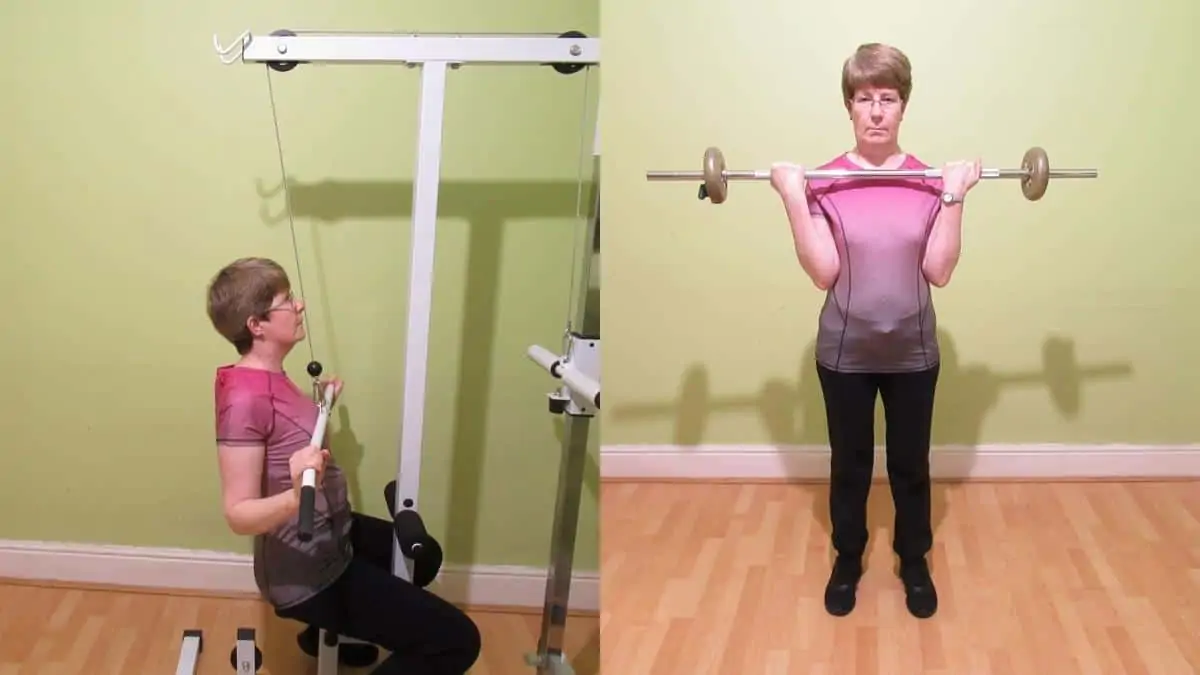The biceps, commonly known as the biceps brachii, are highly active when you train your back muscles. Therefore, it makes perfect sense to perform a back and bicep workout for toning up and sculpting a lean upper body.
This particular back and bicep workout for women trains your muscles with different rep ranges and from a variety of angles so that you can achieve the best possible results. While many of the back exercises use cables, you can get equally good gains by training with bands instead.
We even have an entire article dedicated to resistance band back and bicep workout routines if you’d like more information.
For these back and bicep workouts for women, however, you ideally want to rest 1-2 minutes between sets of compound movements and just 60 seconds between sets of isolation exercises.
We’ve listed the full workout down below, but you can also keep reading to learn more about each movement and how to perform it with the optimal muscle-toning technique.
1: Lat pulldown — 3-5 sets of 8-12 reps
2: Cable row — 3-5 sets of 10-15 reps
3: Lat pushdown — 3-5 sets of 12-20 reps
4: Seated bicep curl — 3-5 sets of 8-12 reps
5: One-arm cable curl — 3-5 sets of 10-15 reps
6: Plate hammer curl — 3-5 sets of 12-20 reps
1. Lat pulldowns — 3-5 sets of 8-12 reps
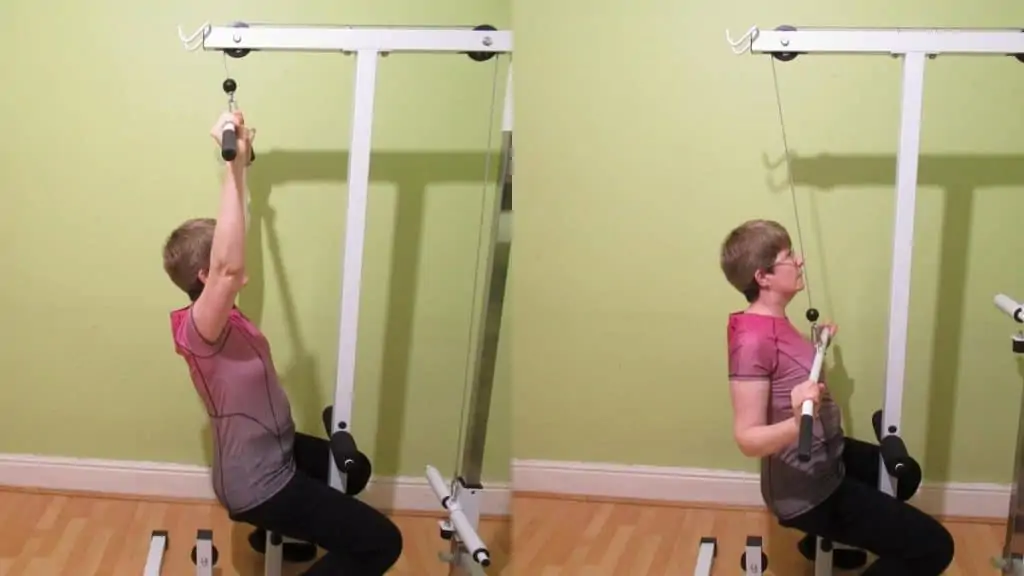
No good back and biceps workout for females is complete without some kind of lat pulldown because it’s one of the best exercises for toning your traps and lats.
While pulldowns don’t tax your core as much as pull-ups, they’re far better for isolating your back muscles because your biceps won’t give out before your lats.
You can also customize the movement to target particular areas of your back.
To work the lower part of your lats, use a wider grip.
Conversely, to train the bulk of the lats and, in particular, the upper part, you can use a close or neutral grip. This is my preferred option because it enables you to lift heavier weights and therefore simulate more lean muscle growth.
- Attach a bar to the pulldown cable.
- Grab the bar and sit on the seat with your knees tucked under the pad.
- Pull the bar to your mid-chest area by flexing your lats (drive your elbows down and slightly inward).
- Keep going until the bar touches your chest.
- Squeeze your back muscles as hard as you can.
- Release the bar under control and let your lats stretch out as you do so.
2. Cable rows — 3-5 sets of 10-15 reps
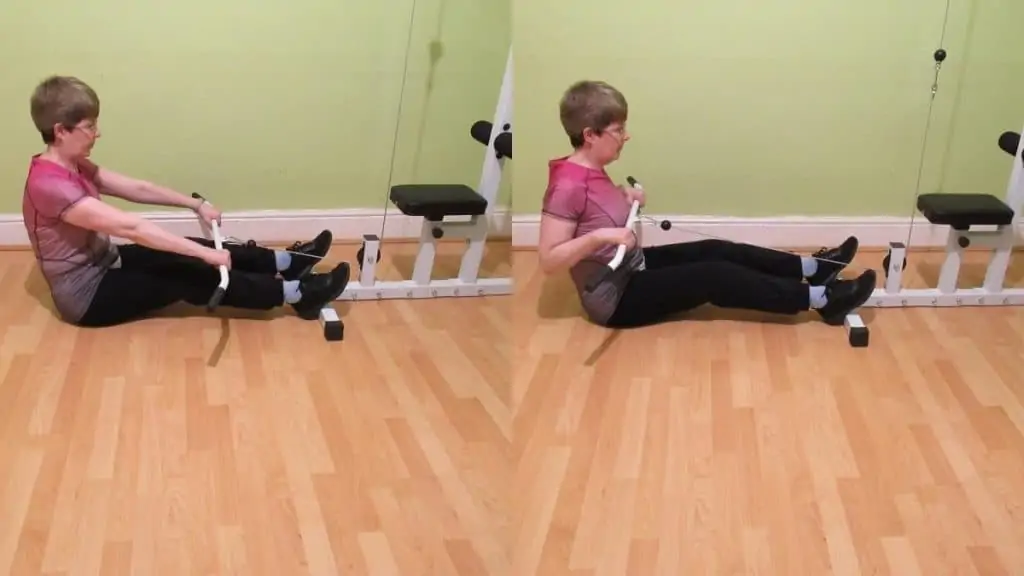
Cable rows are the opposite of lat pulldowns in that they predominantly work the traps over the lats.
That is, of course, unless you use a close or underhand grip, in which case you’ll shift the emphasis onto your lats.
Additionally, you can also row the bar to a lower part of your stomach to target the lats.
Conversely, to get those nice toned traps, you want to use a wider overhand grip and row the bar to your upper abs or lower chest area.
Note that these adjustments apply to all types of rows, not just the cable version.
- Connect your favorite attachment to the cable row station.
- Sit upright on the seat with your feet against the pads.
- Grab the bar with an overhand grip, just outside shoulder-width.
- Row the bar toward your upper abs/lower chest area by contracting your back muscles and squeezing your arms (pretend that you’re pinching a tennis ball between your shoulder blades).
- Hold the contraction for a moment, and then release the bar in a controlled manner until your elbows are extended.
Related: Back shoulder and bicep workout
3. Lat pushdowns — 3-5 sets of 12-20 reps
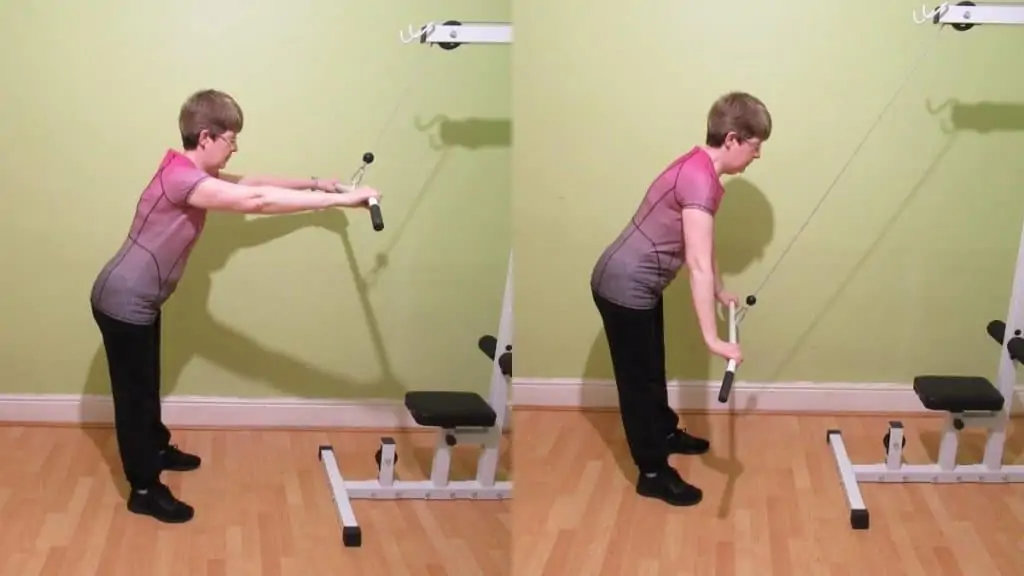
Lat pushdowns make a great addition to any women’s back and bicep workout because they isolate the lats better than virtually any other exercise.
The trick is to maintain only a slight bend in your elbows so that you don’t feel the movement working your triceps too much.
- Connect a straight bar to a high pulley.
- Grab the bar with a shoulder-width overhand grip.
- Bend over at your waist slightly and maintain a small bend in your elbows.
- Push the bar down to your thighs by contracting your lats.
- Squeeze your lats forcefully as the bar makes contact with your legs.
- Release the contraction and lower the bar back up by way of a big lat stretch.
4. Seated dumbbell curls — 3-5 sets of 8-12 reps
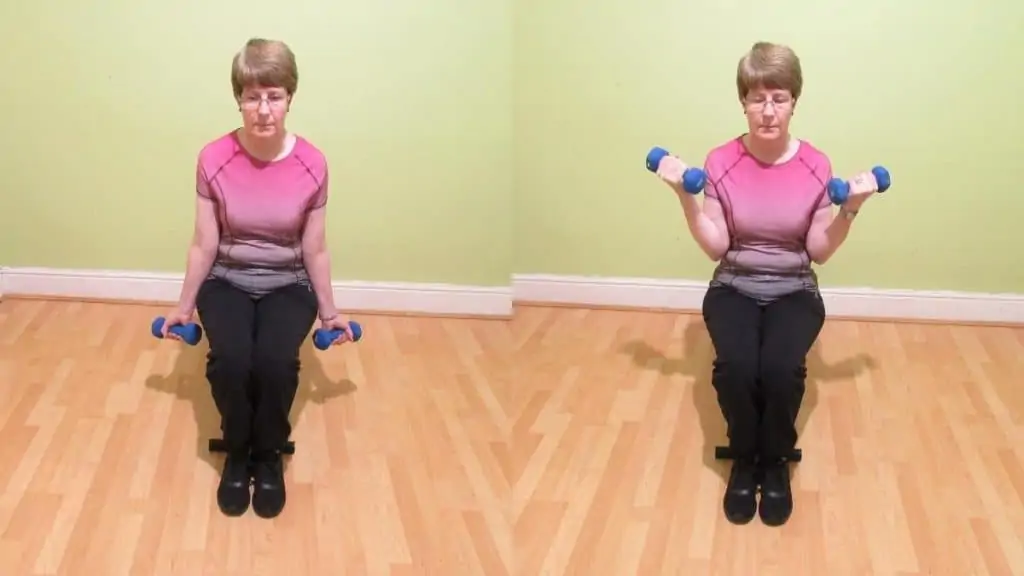
Sitting arm curls are a great exercise for isolating your biceps because the core strength requirement is much lower than the sanding version. This enables you to focus purely on the target muscles to give your biceps the best possible workout.
By using dumbbells, you’ll also sculpt symmetrical biceps by ensuring that each arm is getting equal amounts of work, which in turn will help to make your upper body look more proportional.
Just make sure to really twist your wrists at the top of each rep (turn your pinky fingers away from your body). Doing this intensifies the peak contraction and makes your biceps work harder, which is great for stimulating lean muscle development.
You can also do in out bicep curls if you’re a lady looking for an intense way to blast her biceps.
- Grab a pair of dumbbells with an underhand grip and sit on the edge of a weight bench.
- Curl the dumbbells toward your shoulders while keeping your elbows stationary.
- Keep curling until your lower arms push right up against your biceps.
- Hold the contraction for a moment.
- Lower the weights under control until your arms are locked out.
5. Single arm cable curls — 3-5 sets of 10-15 reps
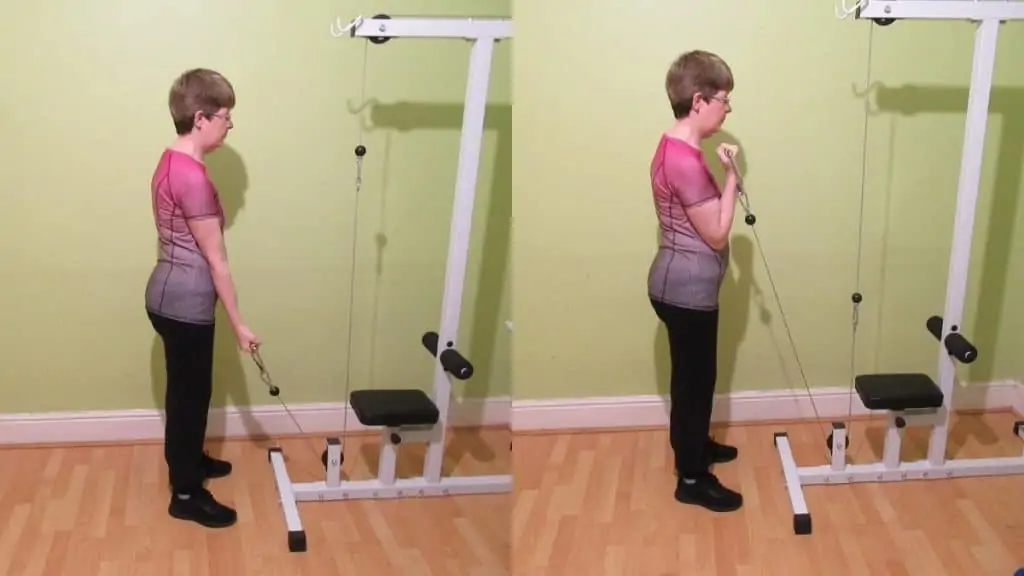
As you’ve probably noticed, this back and bicep workout for females contains a lot of cable exercises.
That’s because cables make your muscles work harder than free weights on a per rep basis. Since the cable pulley is constantly exerting some kind of force on your biceps, your muscles always have to contract against some type of resistance.
So you can’t just rest at the bottom of each rep like you can with dumbbells curls. As such, your biceps will get a really nice (if that’s the right word) burn from unilateral cable curls because the lactic acid can’t escape until your set is over.
- Connect a single handle to a low pulley.
- Grab the handle with a supinated grip.
- Curl the handle toward your shoulder by flexing your biceps.
- Squeeze your biceps forcefully as it presses up against the underside of your forearm.
- Hold the contraction for a second, and then lower the handle under control until your elbow reaches full extension.
- Repeat the movement with your other arm.
6. Plate hammer curls — 3-5 sets of 12-20 reps
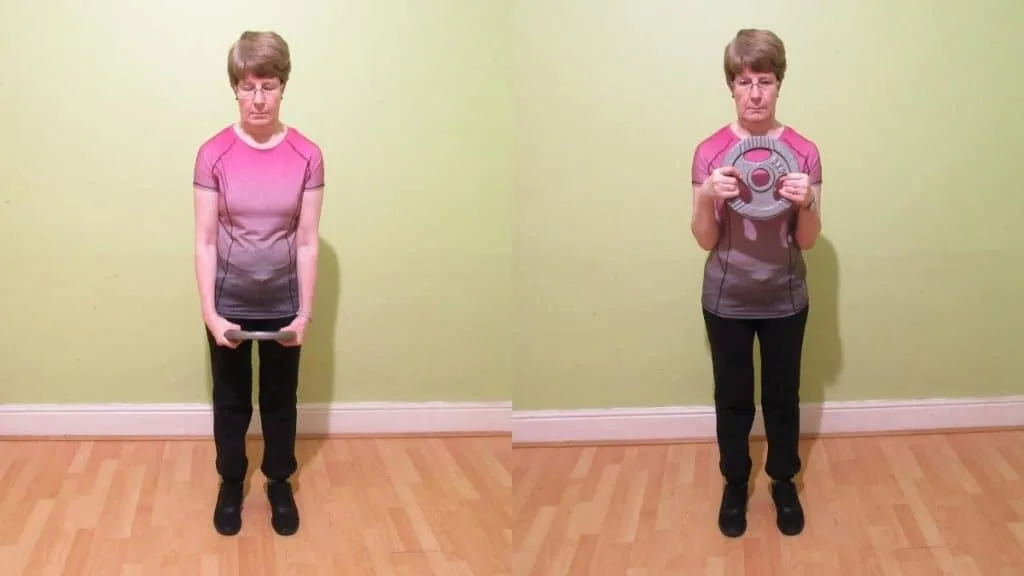
Weight plate hammer curls are the final exercise in our back and bicep workout for women and one that you certainly don’t want to skip (even if you’re really tired after all those pulldowns and rows).
This is because plate hammer curls train your brachioradialis and brachialis in addition to your biceps. These two muscles, when nicely toned, will make your arms look leaner and more defined.
The catch is that they become most active when the biceps are least activate, which is to say when you use either a neutral or reverse grip.
So you can train your brachioradialis and brachialis with plate hammer curls or an overhand exercise like pronated preacher curls instead.
- Grab a weight plate at both sides and hold it in front of your thighs.
- Curl the weight disc toward your chest until your forearms and biceps make forceful contact.
- Squeeze your arms and then lower the plate in a controlled manner until your arms are fully extended.
See Also: Back biceps and abs workout
In conclusion
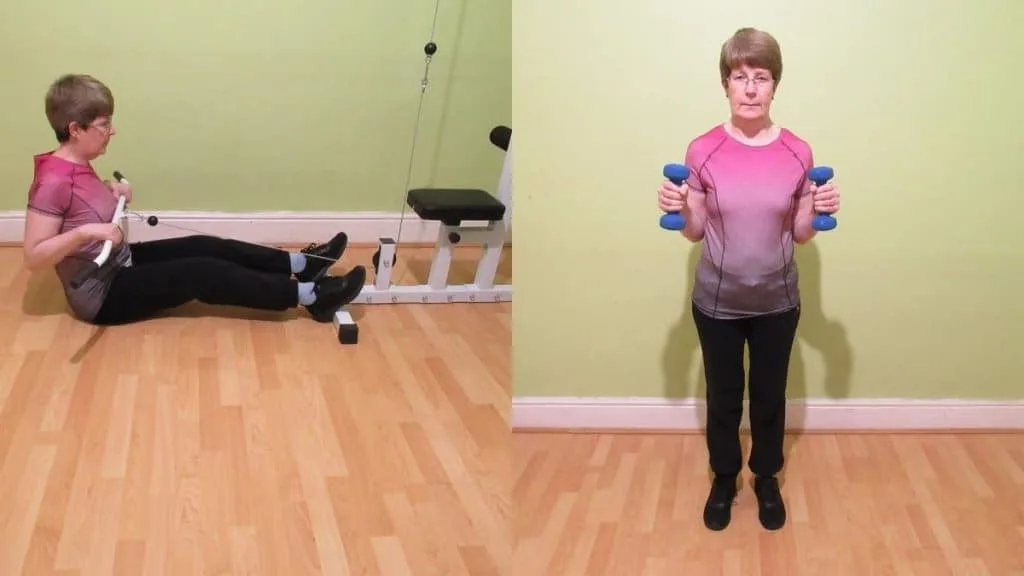
There is, of course, no single best back and bicep workout for women to tone up and build lean muscle.
However, by following a few easy principles, ladies can get a great workout every time and see fantastic results from their efforts.
Essentially, you want to combine vertical pulling movements (like lat pulldowns) with horizontal pulling exercises (like cable rows) so that all of the muscles in your back get enough stimulation.
It’s not that pulldowns don’t work your traps because they most definitely do. It’s just that rows are a better option for toning your traps, whereas pulldowns are the superior choice for sculpting lean lats.
It works the same way with your arms.
Supinated curls are best for building your biceps, whereas hammer curls and reverse curls are more effective for developing your brachioradialis and brachialis.

